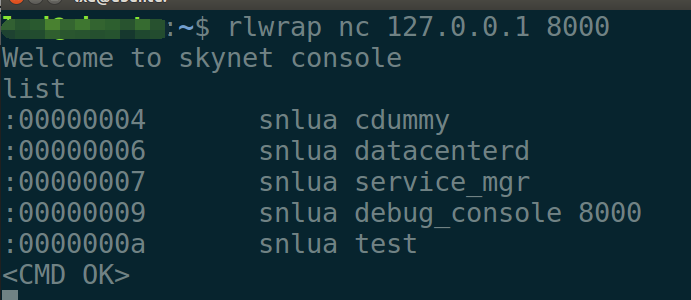skynet有两种方法支持热更新lua代码:clearcache和inject,在介绍skynet热更新机制之前,先介绍skynet控制台,参考官方wiki https://github.com/cloudwu/skynet/wiki/DebugConsole
1. skynet控制台
想要使用skynet控制台,需启动debug_console服务skynet.newservice("debug_console", ip, port),指定一个地址。skynet启动后,用nc命令就可以进入控制台,如图。

debug_console服务启动后,监听外部连接(第3行)。
第15行,当打开控制台连接建立后,fork一个协程在console_main_loop里处理这个tcp连接的通信交互
第6-13行,使用特定的print,数据不是输出到屏幕上,而是通过socket.write发送给控制台
第24-28行,获取控制台发来的数据,然后调用docmd
第35-52行,解析出相应指令,执行完后,通过print发送给控制台
-- service/debug_console.lua
skynet.start(function()
local listen_socket = socket.listen (ip, port)
skynet.error("Start debug console at " .. ip .. ":" .. port)
socket.start(listen_socket , function(id, addr)
local function print(...)
local t = { ... }
for k,v in ipairs(t) do
t[k] = tostring(v)
end
socket.write(id, table.concat(t,"\t"))
socket.write(id, "\n")
end
socket.start(id)
skynet.fork(console_main_loop, id , print)
end)
end)
local function console_main_loop(stdin, print)
print("Welcome to skynet console")
skynet.error(stdin, "connected")
local ok, err = pcall(function()
while true do
local cmdline = socket.readline(stdin, "\n")
...
if cmdline ~= "" then
docmd(cmdline, print, stdin)
end
end
end)
...
end
local function docmd(cmdline, print, fd)
local split = split_cmdline(cmdline)
local command = split[1]
local cmd = COMMAND[command]
local ok, list
if cmd then
ok, list = pcall(cmd, table.unpack(split,2))
else
...
end
if ok then
...
print(list)
print("<CMD OK>")
else
print(list)
print("<CMD Error>")
end
end比如,在控制台输入"list",最终会调用到COMMAND.list(),获取当前服务信息,然后返回给控制台。于是就有了上面截图的信息。
-- service/debug_console.lua
function COMMAND.list()
return skynet.call(".launcher", "lua", "LIST")
end2. clearcache更新方法
clearcache用于新建服务的热更新,比如agent,对已有的服务不能热更新。使用方法很简单:在控制台输入"clearcache"即可,下面分析其原理:
每个snlua服务会启动一个单独的lua VM,对于同一份Lua文件,N个服务就要加载N次到内存。skynet对此做了优化,每个Lua文件只加载一次到内存,保存Lua文件-内存映射表,下一个服务加载的时候copy一份内存即可,提高了VM的启动速度(省掉读取Lua文件和解析Lua语法的过程)。参考官方wiki https://github.com/cloudwu/skynet/wiki/CodeCache
第2-6行,全局的Lua状态机,以Lua文件名为key,内存指针为value,保存在状态机的注册表里,位于栈上有效伪索引LUA_REGISTERYINDEX处。
第8行,修改了官方的luaL_loadfilex接口:
第11-15行,调用load从全局状态机的注册表里获取文件名对应的内存块,调用lua_clonefunction拷贝一份后即可返回
第16-18行,第一次加载文件到内存里
第19-26行,调用save保存文件名-内存块的映射,如果有旧的内存块,返回旧的,否则返回刚加载的内存块
// 3rd/lua/lauxlib.c
struct codecache {
struct spinlock lock;
lua_State *L;
};
static struct codecache CC;
LUALIB_API int luaL_loadfilex (lua_State *L, const char *filename,
const char *mode) {
...
const void * proto = load(filename);
if (proto) {
lua_clonefunction(L, proto);
return LUA_OK;
}
lua_State * eL = luaL_newstate();
int err = luaL_loadfilex_(eL, filename, mode);
proto = lua_topointer(eL, -1);
const void * oldv = save(filename, proto);
if (oldv) {
lua_close(eL);
lua_clonefunction(L, oldv);
} else {
lua_clonefunction(L, proto);
/* Never close it. notice: memory leak */
}
return LUA_OK;
}load接口,从全局状态机CC的注册表里获取指定文件对应的内存块(可能不存在)
// 3rd/lua/lauxlib.c
static const void *
load(const char *key) {
if (CC.L == NULL)
return NULL;
SPIN_LOCK(&CC)
lua_State *L = CC.L;
lua_pushstring(L, key);
lua_rawget(L, LUA_REGISTRYINDEX);
const void * result = lua_touserdata(L, -1);
lua_pop(L, 1);
SPIN_UNLOCK(&CC)
return result;
}save接口,先获取旧的内存块(12-15行),如果有则直接返回,否则把新内存块加载到注册表中(17-19行)
static const void *
save(const char *key, const void * proto) {
lua_State *L;
const void * result = NULL;
SPIN_LOCK(&CC)
if (CC.L == NULL) {
init();
L = CC.L;
} else {
L = CC.L;
lua_pushstring(L, key);
lua_pushvalue(L, -1);
lua_rawget(L, LUA_REGISTRYINDEX);
result = lua_touserdata(L, -1); /* stack: key oldvalue */
if (result == NULL) {
lua_pop(L,1);
lua_pushlightuserdata(L, (void *)proto);
lua_rawset(L, LUA_REGISTRYINDEX);
} else {
lua_pop(L,2);
}
}
SPIN_UNLOCK(&CC)
return result;
}clearcache的原理就是删除这个全局的状态机,这样新服务就可以用最新的Lua文件(load接口返回NULL),且不影响已有服务的运行。此时,新服务运行新的代码,旧服务运行旧的代码。
在控制台输入"clearcache"后,最终调用到c中的clearcache,删除旧的全局VM,然后新建一个(19-20行)。
-- service/debug_console.lua
function COMMAND.clearcache()
codecache.clear()
end
// 3rd/lua/lauxlib.c
static int
cache_clear(lua_State *L) {
(void)(L);
clearcache();
return 0;
}
static void
clearcache() {
if (CC.L == NULL)
return;
SPIN_LOCK(&CC)
lua_close(CC.L);
CC.L = luaL_newstate();
SPIN_UNLOCK(&CC)
}3. inject更新方法
inject译为“注入”,即将新代码注入到已有的服务里,让服务执行新的代码,可以热更已开启的服务,使用方法简单,在控制台输入"inject address xxx.lua"即可,难点在于lua代码的编写,建议只做一些简单的热更。其实现原理是:给服务发送消息,让其执行新代码,新代码修改已有的函数原型(包括upvalues),完成对函数的更新。
第10行,给指定服务发送"DEBUG"类型消息
第20行,最终调用inject接口注入代码修改函数原型(包括闭包)。注:只需修改服务的register_protocol接口以及消息分发接口
-- service/debug.lua
function COMMAND.inject(address, filename)
address = adjust_address(address)
local f = io.open(filename, "rb")
if not f then
return "Can't open " .. filename
end
local source = f:read "*a"
f:close()
local ok, output = skynet.call(address, "debug", "RUN", source, filename)
if ok == false then
error(output)
end
return output
end
-- lualib/skynet/debug.lua
function dbgcmd.RUN(source, filename)
local inject = require "skynet.inject"
local ok, output = inject(skynet, source, filename , export.dispatch, skynet.register_protocol)
collectgarbage "collect"
skynet.ret(skynet.pack(ok, table.concat(output, "\n")))
endinject的处理过程:
第7-9行,获取接口的函数原型(包括闭包),保存在u里
第11-21行,遍历所有的消息分发函数(每种消息类型对应一个函数),通过getupvaluetable接口保存函数原型(包括闭包)
第22-23行,执行新的Lua代码,通过env里的_U,_P获取原有的函数原型
-- lualib/skynet/inject.lua
return function(skynet, source, filename , ...)
local output = {}
local u = {}
local unique = {}
local funcs = { ... }
for k, func in ipairs(funcs) do
getupvaluetable(u, func, unique)
end
local p = {}
local proto = u.proto
if proto then
for k,v in pairs(proto) do
local name, dispatch = v.name, v.dispatch
if name and dispatch and not p[name] then
local pp = {}
p[name] = pp
getupvaluetable(pp, dispatch, unique)
end
end
end
local env = setmetatable( { print = print , _U = u, _P = p}, { __index = _ENV })
local func, err = load(source, filename, "bt", env)
...
return true, output
end示例:比如启动了一个test服务
-- test.lua 1 local skynet = require "skynet"
local CMD = {}
local function test(...)
print(...)
skynet.ret(skynet.pack("OK"))
end
function CMD.ping(msg)
test(msg)
end
skynet.dispatch("lua", function(session, source, cmd, ...)
local f = CMD[cmd]
if f then
f(...)
end
end)
skynet.start(function()
end)在控制台输入"inject address inject_test.lua"热更test服务,
第23行,通过全局环境变量_P获取lua类型消息分发函数里的接口CMD
第24行,获取CMD.ping接口的所有闭包
第25行,得到test的函数原型
第27-30行,更新接口,完成热更。
-- inject_test.lua
print("hotfix begin")
if not _P then
print("hotfix faild, _P not define")
return
end
local function get_upvalues(f)
local u = {}
if not f then return u end
local i = 1
while true do
local name, value = debug.getupvalue(f, i)
if name == nil then
return u
end
u[name] = value
i = i + 1
end
end
local CMD = _P.lua.CMD
local upvalues = get_upvalues(CMD.ping)
local test = upvalues.test
CMD.ping = function(msg)
local postfix = "aaa"
test(msg .. postfix)
end
print("hotfix end")本篇文章就写到这,在2021年1月13/14号我会开一个四小时玩转skynet训练营,也就是两个礼拜之后,现在已经开放报名,对游戏开发感兴趣的诸位同好可以订阅一下,
训练营内容大概如下:
1. 多核并发编程
2. 消息队列,线程池
3. actor消息调度
4. 网络模块实现
5. 时间轮定时器实现
6. lua/c接口编程
7. skynet编程精要
8. demo演示actor编程思维
期待与诸位同好共襄技术盛举
凭借报名截图可以进群973961276领取上一期skynet训练营的录播以及这期的预习资料哦!